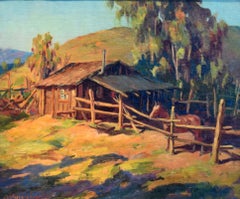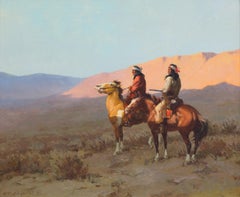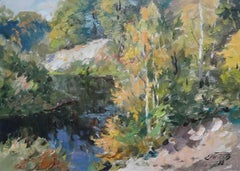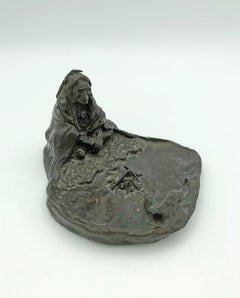Olaf Wieghorst Art
to
1
1
1
1
Overall Width
to
Overall Height
to
4
1
1
1
2
2
2
2
2
1
1
1
1
1
1
1
1
3
2
1
1
1
4
7,736
4,946
2,504
1,373
2
1
4
Artist: Olaf Wieghorst
"Home Corral" Very early Wieghorst California Western Painting awesome colors
By Olaf Wieghorst
Located in San Antonio, TX
Olaf Wieghorst
(1899 - 1988)
California, New York, New Mexico, Arizona, Texas Artist
Image Size: 20 x 24
Frame Size: 29.5 x 33
Medium: oil
1946
"Home Corral" California Olaf Wieghorst
Without a doubt one of if not the most colorful Wieghorst paintings ever done. Signed lower left. Titled on verso. Dated on verso.
In very nice condition. Has been professionally cleaned. Has very fine craquelure in the tree branches and a small spot below the horse that is really only visible if you are extremely close to the painting or with magnification. One of his finest paintings. Also please view my other Wieghorst from the same estate. I have included close up photos as well as photos taken in natural light, spot light and fluorescent lighting.
Olaf Wieghorst
(1899 - 1988)
California, New York, New Mexico, Arizona, Texas Artist
Image Size: 20 x 24
Frame Size: 29.5 x 33
Medium: oil
"Home Corral"
Dated 1946
Biography
Olaf Wieghorst (1899 - 1988)
Born in Viborg, Denmark, Olaf Wieghorst was a child acrobatic performer from the age of nine when he began appearances at Tivoli Theater in Copenhagen and later toured Europe. He also learned horseback riding working on a stock farm, and horses became a major focus of his admiration and later his painting.
In 1918, he arrived in the United States, having worked as a cabin boy on a steamer. He served in the 5th U.S. Cavalry on the Mexican border in the days of Pancho Villa. He later recalled a favorite horse from that period and said that riding through El Paso in 1921, the horse fell on his ankle and broke it. The outfit was heading to Douglas, Arizona, and not wanting to be left behind with his injury, he stayed on the horse which carried him all the way through the New Mexico desert on one of the hottest days of the year. The horse died during the night, having expended all his energy on saving Wieghorst. He later wrote that when the Cavalry discarded the use of horses, "they took the soul out of that great branch of the service" ("Widening Horizons").
He wandered extensively through the West sometimes on horseback, finding work in Arizona and New Mexico as a cowboy. Then he went to New York and served as a mounted policeman until 1944, spending most of his time on a horse named Rhombo patrolling the Central Park bridle paths and saving many people injury from runaway horses. He began painting in his spare time, and he was successful enough that his work was represented by the Grand Central Art Galleries of the Biltmore Hotel.
In 1944, he settled in El Cajon, California. His paintings include cowboys, horses, and Indians in landscape, but there is little if any collectible art of his done during his early days in the West. His primary output came after his return to California when he began painting cowboys and horses extensively. He did numerous horse portraits, spending time on ranches studying their unique personalities. He painted celebrity horses including Roy Rogers' Trigger, Gene Autry's Champion and Tom Morgan's stallion.
He was a large, powerful, handsome, and very personable man.
Source:
Kathleen Wade
Olaf Carl Wieghorst (1899-1988)
He arrived in the U.S. in 1918, joining the U.S.
Cavalry, & patrolled the Mexico border in New Mexico & Arizona . When he mustered out of the army, he drifted, ending up as a wrangler on
the Cunningham Ranch near Alma, New Mexico.
By the mid-twenties,
Wieghorst was in New York City, working as a mounted policeman - his
relationships with the many horses that were a part of his life became
the common denominator of his paintings. Living in California by the end
of WWII, he began a career that spiraled to success, in part due to his
engaging personality.
His paintings have appeared in numerous solo
& retrospective exhibitions including the National Cowboy &
Western Heritage Museum, Oklahoma City (1974), The Tucson Museum of Art,
Arizona (1981), & the San Diego Historical Society, California
(2002).
His work was the subject of the 1970 biography, "Olaf Wieghorst"
by William Reed...
Category
1940s Impressionist Olaf Wieghorst Art
Materials
Oil
Apaches
By Olaf Wieghorst
Located in Palm Desert, CA
"Apaches" is an oil on canvas painting by Olaf Wieghorst. The painting is signed on the lower left, "O-Wieghorst". The framed piece measures 25 1/2 x 29 3/4 x 2 in.
“When the time comes for me to put away my palette and unsaddle my pony for the last time, I hope that my canvases will in some small measure add to the historical recording of an era, the cowboy, and the great American West.” ~ Olaf Wieghorst
Wieghorst worked with the mounted patrol of the 7th Cavalry Regiment of the United States Cavalry (1920-1922) with occasional interludes as a wrangler on ranches in the western states. Wherever he went, he sketched and painted the Western culture he loved, often selling his work as calendar and magazine illustrations.
His work appeared in Zane Grey...
Category
Early 20th Century American Realist Olaf Wieghorst Art
Materials
Canvas, Oil
"INDIAN ON HORSE" WESTERN NATIVE AMERICAN
By Olaf Wieghorst
Located in San Antonio, TX
Olaf Wieghorst
(1899 - 1988)
California, New York, New Mexico, Arizona, Texas Artist
Image Size: 11 x 8.5
Frame Size: 18.5 x 14.5
Medium: Print
"Indian on Horse...
Category
20th Century Realist Olaf Wieghorst Art
Materials
Archival Pigment
Season's Greetings 1960 (Brave on Horseback)
By Olaf Wieghorst
Located in Missouri, MO
Olaf Wieghorst (American, 1899-1988)
"Season's Greetings" (Brave on Horseback) 1960
Watercolor/Gouache on Paper
Initialed and Monogramed and Dated
Dedicated: "To Rosalie & Jack, Season's Greetings, Mae & Olaf Xmas 1960"
Site Size: 12 x 9 inches
Framed Size: approx. 22.5 x 18.5 inches
Born in Viborg, Denmark, Olaf Wieghorst was a child acrobatic performer from the age of nine when he began appearances at Tivoli Theater in Copenhagen and later toured Europe. He also learned horseback riding working on a stock farm, and horses became a major focus of his admiration and later his painting.
In 1918, he arrived in the United States, having worked as a cabin boy on a steamer. He served in the 5th U.S. Cavalry on the Mexican border in the days of Pancho Villa...
Category
1960s American Realist Olaf Wieghorst Art
Materials
Watercolor, Paper, Gouache
Related Items
French Mid-Century Oil on Canvas. 'Arco de Zocodover' in Toledo, Spain.
Located in Cotignac, FR
Mid Century oil on canvas view of the Moorish arch in the Plaza de Zocodover in Toledo, Spain by Louis Léo Hourdille. The painting is signed and titled to the back of the canvas.
Ho...
Category
Mid-20th Century Impressionist Olaf Wieghorst Art
Materials
Canvas, Oil
H 24.41 in W 21.26 in D 1.19 in
Landscape with the river. 1992, cardboard, oil, 49x68 cm
By Edgars Vinters
Located in Riga, LV
Landscape with the river. 1992, cardboard, oil, 49x68 cm
Edgars Vinters (1919-2014)
Edgars Vinters is working in oil, watercolor and monotype techniques. He paints landscapes in dif...
Category
1990s Impressionist Olaf Wieghorst Art
Materials
Cardboard, Oil
H 19.3 in W 26.78 in D 0.04 in
Four Sheep in the Field, Realist, Light/ Shadow Oil Painting 36" x 24" Farm
By Luke Autrey
Located in Houston, TX
Four Sheep in the Field, Realist, Light/ Shadow Oil Painting 36" x 24" Farm The third and fourth photos show thow this painting will look after being professionally taken by 2/23...
Category
2010s American Realist Olaf Wieghorst Art
Materials
Oil, Panel
Autumn. 1967. Oil on cardboard, 68x57 cm
By Edgars Vinters
Located in Riga, LV
Autumn. 1967. Oil on cardboard, 68x57 cm
Edgars Vinters (1919-2014)
Edgars Vinters is working in oil, watercolor and monotype techniques. He paints landscapes in different seasons a...
Category
1960s Impressionist Olaf Wieghorst Art
Materials
Oil, Cardboard
'Boy with a White Cat', Philadelphia Woman Artist, Moore College of Art
Located in Santa Cruz, CA
Signed upper right, 'Anne Jenkins' (American, 1923-2023) and dated 1958.
An elegant and psychologically penetrating study of a young boy, shown seated and holding a white cat.
Born...
Category
1950s Post-Impressionist Olaf Wieghorst Art
Materials
Ink, Gouache, Laid Paper
H 13 in W 10 in D 0.13 in
Realist Blue, Green & Brown Western Landscape of Cowboys Roping a Horse Stampede
Located in Houston, TX
Realist painting of a pair of cowboys attempting to rope a group of running horses set against an open landscape of rocky mountains. Signed by the artist in the front lower right cor...
Category
Late 20th Century American Realist Olaf Wieghorst Art
Materials
Canvas, Oil
H 26.38 in W 37.5 in D 1.5 in
1938 Danish Vintage/antique oil painting on canvas, Horses, Signed dated
Located in Palm Coast, FL
Up for sale is a beautiful vintage/antique oil painting on canvas by Danish Artist depicting horses in the field.
Signed indistinctly in a lower right corner and dated 1938.
Di...
Category
1930s Impressionist Olaf Wieghorst Art
Materials
Oil
H 21 in W 26.5 in D 2 in
SWIFT FOX - GREAT PLAINS WINTER
Located in Aventura, FL
Lithograph on paper. Hand signed, titled and numbered by the artist. Edition of 350.
Artwork is in excellent condition. Certificate of Authenticity is included. All reasonable offers will be considered.
About the artist: A wildlife painter whose work often has sparrows, Michael Dumas...
Category
Late 20th Century Realist Olaf Wieghorst Art
Materials
Paper, Lithograph
Antoine Louis-Barye "Walking Tiger" Antique Engraving by Firmin Gillot ca. 1870
By Antoine-Louis Barye
Located in SANTA FE, NM
"Walking Tiger"
Antoine Louis-Barye
Antique Engraving by Firmin Gillot
Circa. 1870
11 1/3 x 7 3/4 (21 3/8 x 17 1/2 frame) inches
This is "Walking Tig...
Category
1870s Realist Olaf Wieghorst Art
Materials
Black and White
The Great War - Impressionist Oil, Figure & Horse in Landscape by Andre Devambez
By André Devambez
Located in Marlow, Buckinghamshire
Wonderful oil on panel circa 1920 by French impressionist painter Andre Devambez. The work depicts a soldier leading his horse along a dirt track during...
Category
1910s Impressionist Olaf Wieghorst Art
Materials
Panel, Oil
"Head Em Home", Mid Century Cowboy on Horse Western Figurative Landscape
By Stanley M. Long
Located in Soquel, CA
Mid Century figurative landscape of a cowboy on his horse at sundown titled "Head Em Home" by Stanley M. Long (American, 1892-1972). Signed “Stanley M. Long” in bottom right corner. Displayed in a simple wood frame and off-white mat with glass. Image size: 22.75”H x 30.25”L. Frame is 1.5" deep.
Stanley M. Long was a watercolorist who was born in Oakland, CA on May 4, 1892. He spent his childhood on a ranch in Napa where he broke wild horses. He began sketching when quite young and at age 15 enrolled at the San Francisco Institute of Art. He continued at the California College of Arts and Crafts, where he was awarded a scholarship for further study at Académie Julian in Paris.
Long served in the camouflage corps in both world wars. Long taught art in San Francisco at Mission High School and for 17 years at Polytechnic High School. His western illustrations were featured in Sunset Magazine and the Los Angeles Times. Having worked with horses all his life, they were to become the main theme of his paintings.
Member: Society of Western Artists, Napa Valley Art...
Category
1950s American Realist Olaf Wieghorst Art
Materials
Watercolor, Paper
H 29 in W 37.25 in D 1 in
Bovine Beauties Realist, Light/ Shadow Oil Painting 20"x16" Landscape
By Luke Autrey
Located in Houston, TX
Bovine Beauties Realist, Light/ Shadow Oil Painting 20"x16" Landscape . The second image shows how the painting will look. I am waiting for professional photos by 2/14.
Bovine B...
Category
2010s American Realist Olaf Wieghorst Art
Materials
Oil, Panel
H 20 in W 16 in D 1 in
Previously Available Items
Campfire and Buffalo Skull
By Olaf Wieghorst
Located in Missouri, MO
Olaf Carl Wieghorst
"Campfire and Buffalo Skull"
Bronze
approx. 3.5 x 6 x 6 inches
Signed
Born in Viborg, Denmark, Olaf Wieghorst was a child acrobatic ...
Category
Late 19th Century American Realist Olaf Wieghorst Art
Materials
Bronze
"Bronco Buster" SADDLE BRONC RODEO COWBOY WESTERN HORSE RODEO PAINTING
By Olaf Wieghorst
Located in San Antonio, TX
Olaf Wieghorst
(1899 - 1988)
California, New York, New Mexico, Arizona, Texas Artist
Image Size: 10 x 8
Frame Size: 17 x 14
Medium: Watercolor
"Bucking Bronco"
Dated 1946
Biography
Olaf Wieghorst (1899 - 1988)
Born in Viborg, Denmark, Olaf Wieghorst was a child acrobatic performer from the age of nine when he began appearances at Tivoli Theater in Copenhagen and later toured Europe. He also learned horseback riding working on a stock farm, and horses became a major focus of his admiration and later his painting.
In 1918, he arrived in the United States, having worked as a cabin boy on a steamer. He served in the 5th U.S. Cavalry on the Mexican border in the days of Pancho Villa. He later recalled a favorite horse from that period and said that riding through El Paso in 1921, the horse fell on his ankle and broke it. The outfit was heading to Douglas, Arizona, and not wanting to be left behind with his injury, he stayed on the horse which carried him all the way through the New Mexico desert on one of the hottest days of the year. The horse died during the night, having expended all his energy on saving Wieghorst. He later wrote that when the Cavalry discarded the use of horses, "they took the soul out of that great branch of the service" ("Widening Horizons").
He wandered extensively through the West sometimes on horseback, finding work in Arizona and New Mexico as a cowboy. Then he went to New York and served as a mounted policeman until 1944, spending most of his time on a horse named Rhombo patrolling the Central Park bridle paths and saving many people injury from runaway horses. He began painting in his spare time, and he was successful enough that his work was represented by the Grand Central Art Galleries of the Biltmore Hotel.
In 1944, he settled in El Cajon, California. His paintings include cowboys, horses, and Indians in landscape, but there is little if any collectible art of his done during his early days in the West. His primary output came after his return to California when he began painting cowboys and horses extensively. He did numerous horse portraits, spending time on ranches studying their unique personalities. He painted celebrity horses including Roy Rogers' Trigger, Gene Autry's Champion and Tom Morgan's stallion.
He was a large, powerful, handsome, and very personable man.
Source:
Kathleen Wade
Olaf Carl Wieghorst (1899-1988)
He arrived in the U.S. in 1918, joining the U.S.
Cavalry, & patrolled the Mexico border in New Mexico & Arizona . When he mustered out of the army, he drifted, ending up as a wrangler on
the Cunningham Ranch near Alma, New Mexico.
By the mid-twenties,
Wieghorst was in New York City, working as a mounted policeman - his
relationships with the many horses that were a part of his life became
the common denominator of his paintings. Living in California by the end
of WWII, he began a career that spiraled to success, in part due to his
engaging personality.
His paintings have appeared in numerous solo
& retrospective exhibitions including the National Cowboy &
Western Heritage Museum, Oklahoma City (1974), The Tucson Museum of Art,
Arizona (1981), & the San Diego Historical Society, California
(2002).
His work was the subject of the 1970 biography, "Olaf Wieghorst"
by William Reed.
Olaf Carl Wieghorst was born to a display artist and a photo retoucher in Viborg, Jutland, Denmark in 1899. His education was in the Copenhagen public schools and, at a young age, he developed an acrobatic act at the Tivoli Theater in Copenhagen where he was breathlessly billed as "Little Olaf- The Miniature Acrobat." By the age of fourteen Olaf Wieghorst, who would eventually grow to be over 6'4", was too big to be logically referred to as miniature, and started working on a stock farm, where he first learned to ride horses and began to teach himself to paint.
The passion that Olaf Wieghorst developed for horses would be a source of lifelong inspiration. Transfixed by the stories and images of the American west, Olaf Wieghorst joined the crew of a Dutch shipping vessel and promptly jumped ship in New York City, despite the fact that he had $1.25 to his name and knew not a word of English. Olaf Wieghorst joined the US Cavalry and was stationed at the Mexican border as a horseshoer, a job that allowed him contact with his primary preoccupation. He also learned rodeo and trick riding techniques from the men around him and further developed his painting style.
Olaf Wieghorst left the service and worked as a ranch hand in Arizona at the Quarter 2C Ranch, whose brand he adopted as his insignia. Olaf Wieghorst returned to New York City in 1923 and joined the police force, graduating in 1925. He was assigned to the Police Show Team of the Mounted Division, and continued to paint. The first professional representation Olaf Wieghorst had was in 1940 when an agent he had found sold vast quantities of his work to publishers as calendar art and western illustration.
The change in his lifestyle after he began to find artistic success was dramatic. By 1942 his commissioned paintings went for $500 and, two years later, Olaf Wieghorst had retired from the Police Department and was living in El Cajon, CA. Olaf Wieghorst would produce the majority of his life's work in California and would be best known during his lifetime as a painter of horse portraits, including such equine celebrities as Roy Rogers' Trigger and Gene Autry's Champion. ghWieghorst's work is in many prestigious western collections, including those of Barry Goldwater, The Eisenhower Library and the Whitney Gallery in Cody, Wyoming.
Olaf Wieghorst
Born: Viborg, Jutland, Denmark 1899
Important traditional Western painter specializing in horses, painter of horse portraits, illustrator, sculptor.
Wieghorst is the son of a display artist and photo retoucher who became an engraver. Educated in Copenhagen public schools, Wieghorst was "Little Olaf—the Miniature Acrobat" from age nine until 14. Interested in horses, the American "Wild West," and painting while apprenticed in a store an on a farm, he began painting in 1916. Working as a sailor in 1918, he jumped ship in New York City where he enlisted in the United States Cavalry for duty on the Mexican border. During his last three years of military service as a horseshoer, he learned rodeoing and trick riding.
He was mustered out in Arizona, finding work as a ranch hand on the Quarter Circle 2C Ranch who brand is now Wieghorst's insignia. In 1923 he returned to New York City, graduation from the Police Academy in 1925. Assigned to the Police Show Team of the Mounted Division, Wieghorst began to paint in his spare time. In 1940, he found an agent for his paintings, which immediately sold as calendar art and as Western illustrations. By 1942 he was receiving commission for horse portraits and bronzes, with fees up to $500.
In 1944, Wieghorst retired from the Police Department, settling in El Cajon, California in 1945. By 1955 he had a waiting list of buyers. "I try to paint the little natural things, the way a horse turns his tail to the wind on cold nights, the way he flattens his ears in the rain, seasonal changes in the coat of a horse, and the psychology of his behavior. Horses have been my life." Weighorst's biography was published in 1969.
Resource: SAMUELS' Encyclopedia of ARTISTS of THE AMERICAN WEST,
Peggy and Harold Samuels, 1985, Castle Publishing
Acclaimed by critics as the outstanding contemporary Western artist, Olaf Wieghorst earned these accolades during a lifetime of observing, handling and painting horses and the West.
Olaf was born to Karl and Anna Wieghorst on April 30, 1899, in the village of Viborg, Jutland, Denmark. He was only 19 years old when he came to New York on December 31, 1918 aboard an old Danish steamer. He had only $1.25 in his pocket and spoke no English. For better or for worse, Olaf had come to America to stay.
Olaf joined the United States Calvary and requested duty on the Mexican border. This was his dream come true; he was going West! After the military, Olaf drifted and worked as a cowboy. "I have been observing horses for so many years that I guess I've begun to think like one. That's what I mean when I say that the horse has been my greatest teacher. Horses have been my companions under nearly all possible conditions."
Here was a man deeply in love with the West and its people and its way of life. Here was a man possessed with the talent to create on canvas this love.
His paintings are in the great private collections of Western art including those of Clint Murchison, Leonard Firestone, Barry Goldwater, Earl Adams, Sam Campbell, Jack Goodman, Read Mullan, C.R. Smith, Bruce Gelker, Fred Utter as well as The Eisenhower Library, Abilene, Kansas, and the Whitney Gallery, Cody, Wyoming.
Olaf Wieghorst was born in Denmark in 1899, where he first learned the horsemanship that would be a major theme throughout his life. At the age of 19, Wieghorst immigrated to the U.S., where he joined the 5th Cavalry, patrolling the U.S.-Mexican border.
Following his service, he floated around the Southwest, working at times as a cowboy. Eventually settling in New York, Wieghorst was painting in his spare time when his western paintings caught the attention of the Grand Central Galleries, who would exhibit his works.
In 1944 Wieghorst moved to southern California, where the majority of his works were produced. His works remained very much in demand throughout his life, and he was often commissioned to paint horse portraits...
Category
1940s Impressionist Olaf Wieghorst Art
Materials
Watercolor
Olaf Wieghorst art for sale on 1stDibs.
Find a wide variety of authentic Olaf Wieghorst art available for sale on 1stDibs. You can also browse by medium to find art by Olaf Wieghorst in paint, oil paint, archival pigment print and more. Much of the original work by this artist or collective was created during the 20th century and is mostly associated with the Impressionist style. Not every interior allows for large Olaf Wieghorst art, so small editions measuring 9 inches across are available. Customers who are interested in this artist might also find the work of Max Ferguson, Cecil Crosley Bell, and Frank Henry Mason. Olaf Wieghorst art prices can differ depending upon medium, time period and other attributes. On 1stDibs, the price for these items starts at $420 and tops out at $87,500, while the average work can sell for $22,000.






